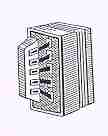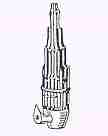
Illustration 2. Demian's accordion.
(from the archive of A. Mirek)

Demian's accordion was very simple: two key-activated diatonic single-action harmonicas connected by bellows; the left side of the instrument had a few buttons which produced different chords, hence the name accordion. (Both the French word accord and the German word akkord mean chord in English.) Yet Demian's invention, however important, was simply one stage in the development of the long line of the free-reed instruments.
The evolution of the accordion began in China, sometime during the third millennium B.C., with the sheng — literally "sublime voice" — which is the earliest known example of a free-reed instrument. According to oral tradition it was invented by the female sovereign Nyn-Kwa in 3000 B.C. The sheng had a gourd as a wind-chamber and thirteen to twenty-four bamboo pipes. At the base of each pipe a tongue was cut in such a way as to vibrate freely when the player blew into the instrument through the mouthpiece and covered the hole in the side of a pipe with a finger. The sheng was formed to imitate the shape of the Phoenix bird and it is probably because of this tradition that it is still used today in China for funeral processions.

Richard Martin, author of The Harmonica: A Mouthful of Music, described an instrument which apparently pre-dated the sheng: "There was a primitive mouth-organ in use among the Chingmiau tribes (non-Chinese people related to the Thai-speaking people of Haenan) near Anshuenn, Gueyjou Province, China (date unknown). This mouth-organ resembled the sheng, and it had six bamboo tubes of various sizes. The bamboo tubes were held in place with strands of bamboo. The tubes were then fitted into and around a wooden wind chest with a mouthpiece. The copper reeds were tuned, with blobs of wax, to the scale D F G A C D. All tones of the scale are in the octave below middle C."
The sheng was either brought to Central Europe by Marco Polo in the thirteenth century or else it found its way there with the Tartars via Russia during the migrations of the peoples. In the 1740's, Johann Wilde, the inventor of the nail violin, somehow discovered the instrument and popularized it by playing it for the Court Society of Petersburg.
French sources, however, claim that the first sheng to appear in Europe was sent to Paris in 1770 by Father Pere Amiot, a Jesuit missionary in China, and that, by some unknown means, it was sent to Russia shortly after. Joseph Macerollo, the author of Accordion Resource Manual, wrote, "Corroboration of detail becomes increasingly difficult since both Russian and French accounts vie with one another as to leadership in the scheme of invention."
The physicist, Christian Gottlieb Kratzenstein from Copenhagen, often heard Wilde play the sheng in Petersburg and became fascinated with the sound of the instrument. Kratzenstein examined the sheng and invented an instrument which produced five vowel sounds by the principle of the free-reed. In 1770 he reported the results of his experiment and in 1782 he was awarded a PAS premium (St. Petersburg Academy of Sciences).

The organ builder Kirsnik, who helped Kratzenstein in his experiments with the free-reed, built an instrument with an organ-style keyboard for the right hand and bellows which were pumped by the left hand. This became known as "Kirsnik's harmonica."

In 1788 during a tour of Petersburg, Georg Joseph Vogler saw Kirsnik's harmonica and commissioned the Swedish master Rakwitz, whom he met in Warsaw, to build him a free-reed instrument similar to Kirsnik's harmonica, but on a larger scale, like an organ, with four keyboards of sixty-three notes each and a pedalboard of thirty-nine notes. The instrument was completed in 1790 and became known as Vogler's orchestrion.

In 1821 Christian Friedrich Ludwig Buschmann (1805-1864) of Berlin invented a mouth organ with fifteen metal reeds which he called the aura (mundaeoline). This was a diatonic single-action instrument and was shaped like the familiar harmonica.
The next year (1822) Buschmann invented the first hand-held bellows-driven free-reed instrument, the handharmonika, or handaeoline,which was designed as a pitch aid for tuning organs. This is considered by some to be the first accordion, despite the fact that it played only single notes, not pre-set chords, like Demian's invention.

In 1825 the British physicist, Sir Charles Wheatstone, invented the symphonium, a hand-held instrument with twelve buttons on each side. The player blew air into it, like a mouth-organ.

Wheatstone improved on the symphonium by adding bellows in 1827. At first, he called it simply symphonium with bellows, but later changed the name to concertina. An illustration of an early species of concertina appeared in his June 19, 1829 patent ofthe symphonium. After fifteen years of development, Wheatstone finally patented his creation in February 1844: a hexagonal-shaped double-action forty-eight key instrument with single-note buttons for both hands with a range from g to c''''.

| Back to History of the Free-Reed Instruments |
| Back to The Classical Free-Reed, Inc. Home Page |